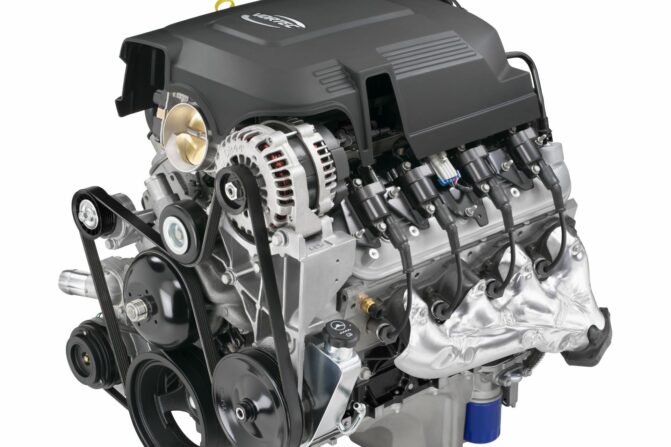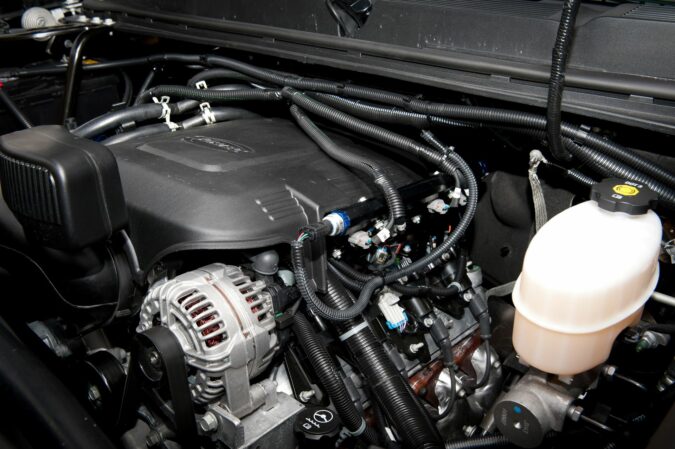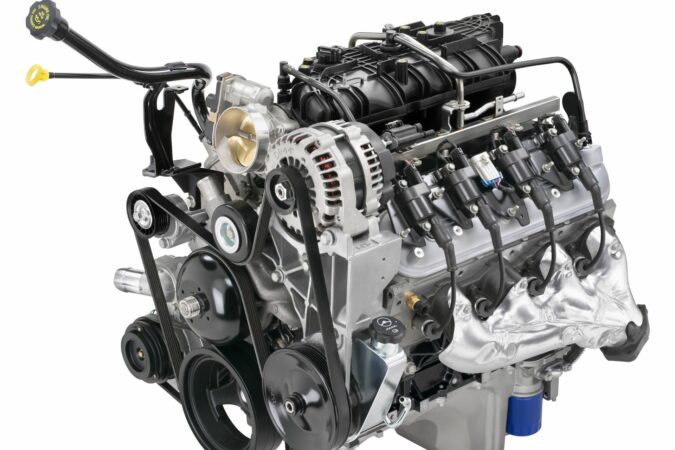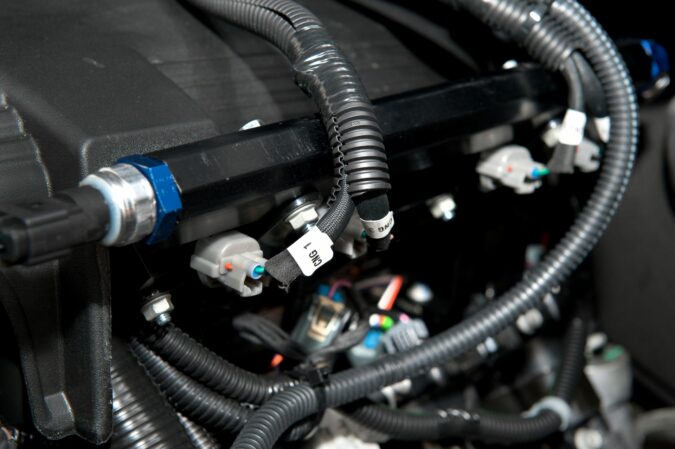Are you planning to get a Chevy truck on the used market and you want to learn more about this 6.0 GM engine? Well, if that is the case, then you are at the right place because in this article, there will be quite a lot to cover on this topic and we are going to learn all about this GM engine.
- History Of GM
- What Is The 6.0 Vortec?
- 6.0 Applications
- 6.0 Specs
- Vortec Problems
- Reliability
- Life Expectancy
- Conclusion
- FAQs
Performing good and thorough research on a car before you buy is something that should be your regular practice. This practice will save you a ton of money in the long run because each vehicle is equipped with different powertrain options.
And the powertrain is basically the transmission and engine combo. And this combination can be pretty good. Or it can be pretty bad in some cases. That’s why you need to learn if a certain engine or transmission is any good before you decide to spend a ton of money on a truck.
Especially when it comes to possible problems. And problems when it comes to trucks can be really expensive to fix. Trucks are not your regular Civic or some economy car. This is why thorough research is needed. And we are going to help you out in this aspect.
First, we are going to learn more about GM and what they are. Then we will take a look at the 6.0 GM engine. We will cover the specs, applications, and most important problems that this engine has and we will also give it a reliability score. So, if you want to learn more, follow along.
History Of GM
Now before we dive into the 6.0 GM engine, let’s first take a look at what is GM in general. Why do we think that this is necessary to elaborate? Well, people are facing similar issues and are often confused by these abbreviations. And this is why we feel the need to further elaborate on this and explain in-depth what GM is.
So, let’s dive into it. GM if you didn’t know, stands for General Motors. General Motors was the biggest car company in the world at one point before getting surpassed by Toyota in 2008. And still one of the top three American carmakers along with Ford and Chrysler.
But what many people don’t know is what GM represents. In other words, what are the GM marques? If you didn’t know, GM builds cars but its cars are not named GM. They have different names.
The first and probably most common connection that people make with GM is Chevy. Chevrolet is one of the best-selling marques that GM has nowadays along with GMC. GMC basically refers to GM’s truck division. This name was derived from General Motors Coach Division. And GMC is predominantly truck and SUV-oriented nowadays.
Other brands that GM owns are Buick and Cadillac. With Cadillac being the more successful of the two. Even though a modern Cadillac is not something that it represented back in the day. The same story is for Buick. These two brands somehow fell behind the successful Chevy and GMC.
But GM does not give up on them, Buick is still quite popular in China and Cadillac is slowly gaining some of the lost audience with its new models. But what is the GM 6.0 engine? More about that, we are going to learn next.
What Is The 6.0L GM Engine
Now as we cleared the basics out of our way, we can slowly move on and learn more about what is the 6.0 GM engine. What makes this type of engine special and what are the different variations of this engine model? Let’s elaborate.
The 6.0L engine was Chevy’s take on the truck market engine. They were tired of the old unreliable designs and wanted to create something from a clean sheet of paper. Something more modern and not adapted to run on modern fuel injection like the engines from the late 80s and early 90s.
So, Chevy has created the 6.0L Vortec engine in 1999 and this engine was produced until 2020 when it got replaced with a new engine.
The 6.0 Vortec engine, even though it is a truck engine and designed to run on trucks and heavy-duty machinery. It is still a small-block Chevy LS engine. And this engine also can be pushed quite a lot in terms of horsepower gains just like any other Chevy LS.
This engine brought many new technologies like the variable camshaft phasing. Active Fuel Management systems shut down two cylinders in order to improve fuel efficiency and other tweaks that maximized the performance gain and made these engines the most fuel-efficient for their time.
There are a lot of different variations of the 6.0 GM engine. The first one introduced was the Vortec LQ4, then the LQ9 followed which was a special high-output engine for Cadillacs. As well as the LY6.
Then in 2007 was released the L76 and L77 in 2011. In 2009 the L98 and in 2010 the L96 (flex fuel) were released. There was also the LY6 and the LFA and LZ1 intended for hybrid use.
6.0 GM Engine Applications
Now that we covered the basics of the 6.0 GM engine and learned that this is an engine derived from the small block LS design. It is worth noting the applications in which you can find these engines. Since they are not available in every GM product out there.
The first generation LQ4 engine was included in the 1999 to 2006 Chevy Silverado 1500/2500/3500. Also, in the GMC Sierra from 2001 to 2006. This engine also came in the SUV segment.
Namely, the Chevy Suburban and GMC Yukon between 2000 and 2006. In addition to this, this engine can be found in the Chevy Express and GMC Savana vans between 2003 and 2008. Also, in the Chevy W-Series and Isuzu NPR trucks between 2003 and 2008.
The LQ9 was a high-output version of the LQ4 and this engine was included in some of the higher-output Cadillac, Chevy, and GMC models.
The L76 released in 2006 was introduced in the Holden Commodore, Holden Statesman, Pontiac G8, Chevy Suburban, Chevy Avalanche, Silverado, Sierra, Yukon, and the 2020 Ginetta Akula.
The L77 was a flex-fuel version of the L76 and this engine was included in the Chevy Caprice PPV between 2011 and 2017.
The LFA and LZ1 were included in the hybrid offering in the period between 2008 – 2009 and 2010 – 2013, respectively.
Overall, these are the major applications of the Vortec 6.0 GM engine over the years. Even though this engine was included in many applications, nowadays there are no new vehicles that are using this engine.
And what makes this engine good is the tunability. There are vast numbers of these engines in every junkyard across the country. And with a little bit of tuning, you can make a real powerhouse.
6.0 GM Engine Specs
Now let’s discuss more about the specs of the 6.0 GM engine and learn more about what are the main characteristics of this engine.
As you can tell, we covered many variations of the engine and not all of them pack the same specs. They are rated differently and pack some technologies. For example, newer 6.0L V8 engines have AFM, while the others do not, also the power numbers are different.
Nevertheless, the 6.0L is basically an LS block with a total of 364cu in displacement. The first type known as the LQ4 had a bore of 4 inches and a stroke of 3.62 inches.
The block is made out of aluminum or iron depending on the version of the engine. While the cylinder heads are always made out of aluminum in order to be lightweight. The intake manifold is made out of plastic as with other modern engines.
This often causes air leaks on the LS engines since the gaskets fail or the manifold cracks but that’s how things are nowadays. In terms of power, the engine develops somewhere between 300hp and 362hp. And 360lb-ft and 380lb-ft of torque depending on the variation that you are using.
Also, the compression ratio might vary from engine to engine. So, in the LQ4, the compression is rated at 9.4:1, while in the LQ9 the compression is 10.0:1. In addition to this, there are also other features that some engines have, like for example better flowing heads, and camshafts tweaked for maximum performance.
And lastly, to add the capability of running different fuels. Some are designed for hybrid vehicles. Like the LFA and LZ1. Others like the L96 are designed for E85 fuel. There are many variations of the 6.0 GM engine.
6.0 GM Engine Problems
If you want to be absolutely sure as to what specific variation of the 6.0 GM engine you have, feel free to check out our guides on the Chevy engine serial number lookup, as well as the GM engine serial number lookup to help you decode the engine.
Now let’s move on and learn more about the 6.0 GM engine problems and further elaborate on the issues that this engine is struggling with.
We can take note that these engines, even though are quite bulletproof, they still have some issues here and there. Nothing is perfect and these engines are not perfect as well.
Even though the problems are not crazy expensive to fix and rarely affect the longevity of the engine. So, what are these problems? Let’s elaborate more on them in the following chapters.
1. Oil Consumption When AFM Is On
The first problem of the 6.0 GM engine that we are going to cover is the increase in oil consumption when the AFM system is on. But what is AFM?
Well, AFM is the Active Fuel Management System that’s used in the Vortec engine. This system basically shuts off two cylinders when the engine is not under load and you are cruising on the highway. This system was created for the purpose to save some fuel in the process.
But even though there is no fuel in these cylinders, the pistons are still moving and this is basically an abnormal condition to have pistons moving while you don’t have combustion.
That part of the block can get colder and cause the rings of the piston not to seal well and allow oil to leak and burn when the AFM shuts off. Creating a lot of carbon on the pistons and also burning a lot of oil in the process.
Some people simply choose to delete this AFM system. And there are options out there that you might want to check in order to sort out this problem on your 6.0 GM engine.
2. Oil Pressure Light
The next problem is a rather small issue that is also caused by the AFM system. And this causes the oil pressure light to turn on.
So, when the AFM system is on, the oil-sending unit might have problems and show a false positive and tell you that you have high or low oil pressure.
Still, check the oil level when you note this problem since the engine oil level will tell you if your engine has a problem or the oil-sending unit is simply broken or the AFM is causing the matter on your 6.0 GM engine. Now let’s move on to the next problem with this specific engine that can happen more often.
3. Throttle Body Sensor Failure
The next problem that can often cause major hurdles for owners of the 6.0 GM engine is the throttle body sensor. So, what is a throttle body sensor?
Well, the throttle body sensor is the sensor that monitors the position of the throttle butterfly flap. This sensor then collects this data and sends it to the ECU and the ECU adjusts the air-to-fuel ratio in the engine.
And when the throttle body position sensor fails, a lot of problems can happen. With the most serious being the engine work. This problem could lead to symptoms associated with this component.
Some of these symptoms of a bad throttle body can include bucking or jerking of the vehicle, hesitation when accelerating, surges in speed when you drive the truck, problems with the idle, and engine stalls. And the most common symptom is the check engine light.
Usually, when this problem happens, a P0122 code is triggered. And you can sort out this problem by replacing the component. Not a crazy expensive replacement. These sensors usually cost anywhere between $75 and $130 on your 6.0 GM engine.
4. Knock Sensor Failure
The next very common problem with the 6.0 GM engine is the issue with the knock sensor on this engine. But what is a knock sensor?
Well, a knock sensor is something like a microphone. This is a sensor that is bolted on the engine block and the sensor basically records certain noise frequencies.
Engines knock when they have mechanical problems or low-octane fuel. So, what the sensor does is record these knocks and tell the engine that there is a problem. Then the engine will readjust the camshaft or do some tweaks on the air-to-fuel ratio to reduce this knocking.
And when the sensor fails, it could start sending check engine light messages and will surely throw some codes. In addition to this, you might also suffer from performance problems like reduced engine power and increased fuel consumption.
Fixing this problem quickly will be really beneficial for your 6.0 GM engine, since this is a really cheap component, you should not delay replacing it. So, make sure you’re diligent about any bad knock sensor symptoms, and proceed with a knock sensor replacement as soon as you can.
5. Broken Exhaust Manifold Bolts
The next problem with this 6.0 GM engine is probably the issues with the exhaust manifold bolts. And what is worth noting is that this is a problem that bothers a lot of trucks and big SUVs. So, why is this the case?
Well, this is often the case for the bolts to break because they are exposed often to salt. And salt can ruin the bolts completely. And another big factor that plays a big role in this is the many heat cycles.
Truck engines are pushed really hard, they run 24/7 in some cases when they are used for work. And all this use and abuse affect the manifold bolts and these manifold bolts are often starting to break down and allow leaks to develop.
So, when a bolt breaks, you might start experiencing a carbon monoxide smell inside the cabin, as well as a hissing noise coming from the engine, or even smoke from the engine in extreme cases.
That’s why you should fix this problem on the 6.0 GM engine. And luckily is not crazy expensive, for a few hundred dollars your engine will be retreaded and you will resume driving.
6. Water Pump Failure
And the last common problem with this specific engine is the situation when the water pump fails. And these failures are not quite common, and it helps that the symptoms of a bad water pump are recognizable. Usually, these water pumps fail well above 150,000 miles.
And is really important to replace this water pump as prevention when the truck hits 150,000 miles. Mainly because if you leave it like that, you will face issues with overheating. And if this is not detected on time, the whole engine can fail. To find out more, check out our guide on what does a water pump do for your car.
Symptoms that are associated with this problem are often issues with overheating, leaks from the water pump, low engine coolant light, steam coming from the front end of the truck, and also noises coming from the front end of the truck. If you’re going to replace it, make sure you’re wary of the water pump replacement cost.
6.0 GM Engine Reliability
In terms of reliability, we can say that the 6.0 GM engine is a fairly reliable one. But take note that these engines are not into production since a long time ago.
And this basically means that these engines have a lot of miles on them. Not that they will not be able to be pushed for a lot more. But most of these trucks are in desperate need of a rebuild or complete long-block replacement (be sure to check out our guide on long block vs short block to know what you need).
This is why we advise that you go for a lower-mile engine if you can afford to pay more money because the more you pay, the less chance will be for you to end up with a completely worn-out 6.0 GM engine.
6.0 GM Engine Life Expectancy
When it comes to the life expectancy of this engine, many people claim that these engines can be pushed well over 300,000 miles.
Anything above 300,000 miles can be considered a seriously worn-out engine. So, the sweet spot is usually somewhere above 150,000 miles if you want to have this engine for a really long time.
Not that there are any good running engines after 300,000 miles. But the chance of them breaking down is quite big. And for a new crate engine, you can expect to pay about $4,000. Which is still cheap considering the number of miles these engines last.
6.0 GM Engine: In Conclusion…
In this article, we covered quite a lot when it comes to the 6.0 GM engine. First, we learned about GM and which brands fall under GM’s hat. Then we elaborated on the 6.0 engine.
We covered the specs of the engine and applications in which you can find the engine. As well as the common problems that are associated with the Vortec engine. Lastly, we discussed the reliability and life expectancy of this engine.
Frequently Asked Questions
Now let’s answer some frequently asked questions.
What Is An LS Engine
An LS engine is a small block engine manufactured by Chevrolet. This engine is used in a lot of applications, starting from trucks, SUVs, and even sports cars like the Corvette. The engine is simply a bulletproof design that easily outmatches the competition.
What Is An LS Swap
An LS swap is a procedure of swapping an existing engine for an LS engine. And this swap is often done in non-GM cars. There are a lot of Porsche 911 LS swaps, and even Tesla LS swaps believe it or not. So, we can say that these swaps are kind of popular.
Are Corvettes Reliable
Yes, Corvettes are one of the most reliable cars around. These vehicles can be easily pushed well over 400,000 miles with no major problems. This is the case because of the reliable LS powertrain.
What Is A Vortec Engine
A Vortec engine is an LS engine made by Chevy but purposefully designed for truck and SUV use. So, these engines are not designed as high-performance versions. And Vortec engines also create less power than the regular LS.
How Much Hp Does A 6.0 Vortec Have
The Vortec makes anywhere between 300hp and 362hp depending on the application and the type of the engine. There are more than a few engine codes of the Vortec 6.0 engine. So, they perform somewhat differently.
Is A 5.3 a 350
No, the 5.3 is not a 350. In fact, this engine is the replacement for the Chevy 350. The 5.3 has fewer cubic inches than the 350 engine. The 5.3 has 325 cubic inches. A difference of 25 less for the 5.3 engine. Also, the 5.3 is an LS design engine and not comparable in any way with the old-fashioned 350 engine.




